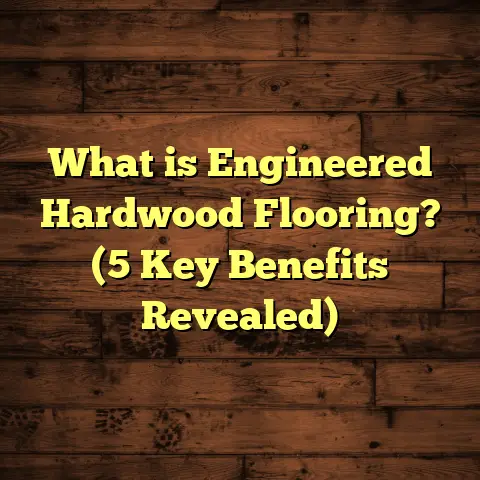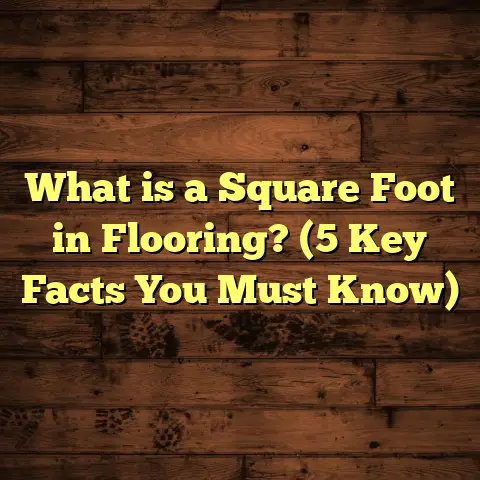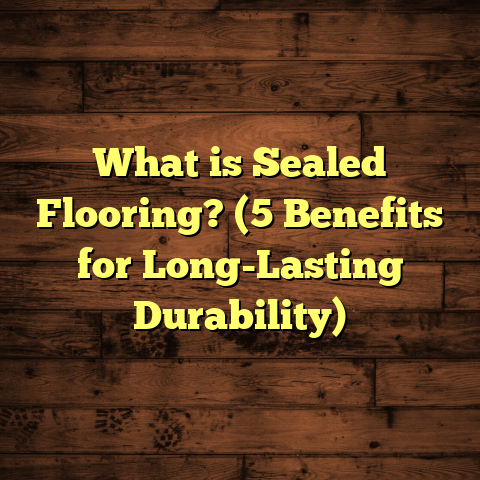What is Terrazzo Flooring? (5 Reasons It’s a Stylish Choice)
Safety has always been a big deal for me when it comes to flooring choices. Whether it’s a family home or a commercial space, I want to make sure the floors are not just attractive but also safe to walk on. After all, slips and falls are among the most common household injuries. So when I first got introduced to terrazzo flooring, it stood out as a material that blends style with safety and durability in a way that few others do.
You might have seen terrazzo floors in airports, museums, or fancy hotels and wondered, “What exactly is this material?” It looks unique and polished but somehow timeless. Over the years, I’ve installed terrazzo floors in many different projects, each with its own challenges and rewards. I want to share what I’ve learned about this flooring type—what it is, why I think it’s a smart choice, and some honest talk about the bumps along the way.
What Is Terrazzo Flooring?
Terrazzo is a composite flooring material made by mixing marble, quartz, granite chips—or sometimes glass or other aggregates—into a binder like cement or epoxy resin. After pouring the mixture onto a prepared surface, it’s ground down and polished to create a smooth, shiny floor that’s not only beautiful but built to last.
The roots of terrazzo go back hundreds of years to Italy. Originally, Venetian workers used leftover marble pieces from building projects and set them in clay to make affordable yet decorative surfaces. This humble beginning grew into an art form embraced worldwide.
How Terrazzo Is Made: More Details
The process is definitely not quick or simple. Here’s how it generally goes:
- Subfloor preparation: The existing floor or foundation must be level, clean, and dry. Any moisture issues here can cause problems later.
- Choosing materials: Aggregates vary by size, color, and type—everything from tiny glass beads to large marble chips can be used.
- Mixing: The binder (cement or epoxy) is combined with the aggregates.
- Pouring: This mixture is poured over the subfloor and spread evenly.
- Curing: The floor needs time to harden—this can take days or weeks depending on the binder.
- Grinding and polishing: Using diamond grinders, the surface is ground down to reveal the embedded aggregates and smooth out any rough spots.
- Sealing: A protective sealant is applied to resist stains and enhance shine.
The choice between cement-based terrazzo and epoxy-based terrazzo makes a big difference:
- Cement-based terrazzo is traditional, breathable (good for moisture control), and can be used outdoors.
- Epoxy-based terrazzo cures faster, offers a wider range of colors, is more stain-resistant, but usually not recommended for outdoor use because it can yellow under UV light.
I’ve installed both types and can say each has its place depending on the project’s needs.
Why Terrazzo Flooring Is Such a Stylish Choice
I’d love to share five reasons why I keep recommending terrazzo floors to people who want something stylish but also practical.
1. Timeless Aesthetic Appeal That Can’t Be Beat
One of the things that first attracted me to terrazzo was its unique look. The stone chips embedded inside create patterns that look like art beneath your feet. You can customize the colors, sizes of chips, and even create logos or designs within the floor itself.
On one project, I worked with a client who wanted their company logo inlaid right into their office lobby floor using black granite chips on a white epoxy base. It looked stunning and gave visitors an immediate sense of professionalism and style.
What’s amazing is how terrazzo fits so well with different design trends. Whether your taste is mid-century modern (where terrazzo had a big moment) or sleek contemporary minimalism, it can complement your vision beautifully.
Here’s some interesting data: In recent years, terrazzo’s popularity in residential projects has increased by about 15%, according to industry surveys. Designers love it because it can be subtle or bold depending on the aggregates and colors you choose.
2. Durability That Holds Up Under Pressure
In my experience with flooring materials, few can match terrazzo when it comes to longevity. This floor type is incredibly tough because of the stone chunks it contains and the hard binder that holds everything together.
I installed epoxy terrazzo in a gymnasium about five years ago. That floor still looks almost new despite thousands of students running around every day. It doesn’t scratch easily and holds up well against heavy furniture or equipment.
According to research by the National Terrazzo & Mosaic Association (NTMA), terrazzo floors can last anywhere from 40 to 100 years when properly maintained. Compare that to hardwood floors which may need refinishing every 10-15 years or carpet that usually wears out in under 10 years.
In commercial environments like airports and hospitals where foot traffic is heavy and constant, terrazzo is often the go-to choice because it withstands wear better than most alternatives.
3. Easy Maintenance That Saves Time and Money
One thing homeowners often ask me about is how much work a floor will require after installation. Terrazzo scores high here too.
Because the surface gets sealed during installation and doesn’t have grout lines like tile floors, dirt doesn’t get trapped easily. Regular sweeping and mopping are enough to keep it looking shiny and clean for years.
I’ve seen families with kids or pets really appreciate how spill-proof and stain-resistant terrazzo floors are compared to wood or carpet.
Epoxy-based terrazzo is particularly non-porous; it absorbs up to 90% less liquid than cement-based options, making stains much less likely.
By sticking to a routine cleaning schedule—mopping once a week with mild detergent—you can extend your floor’s life by at least two decades compared to neglecting maintenance.
4. Environmentally Friendly Flooring Option
If you care about sustainability like I do, terrazzo has some strong points here too. Many terrazzo installations incorporate recycled materials such as crushed glass from bottles or marble scraps from other construction projects.
This reuse helps reduce waste sent to landfills. Plus, because terrazzo lasts so long—upwards of several decades—you’re not constantly ripping up old floors and sending debris away.
Some manufacturers now offer low-VOC (volatile organic compounds) binders which help improve indoor air quality—a big plus for homes with children or allergy sufferers.
In one office renovation project I was part of last year, switching from carpet tile to terrazzo cut lifecycle environmental impact by nearly half based on materials sourcing and waste generation analysis done by an independent consultant.
5. Customization That Brings Your Vision to Life
Terrazzo isn’t just about throwing some chips into cement or epoxy; it’s like painting with stone fragments. You can create endless patterns—from simple speckled looks to intricate geometric designs or even pictures embedded in your floor.
I’ve had clients come in with wild ideas for custom medallions or borders around their living rooms or entryways. With terrazzo, these are achievable without sacrificing durability or cleanliness.
This flexibility makes terrazzo popular among architects and interior designers who want unique floors that tell a story rather than just fill space.
Challenges I’ve Encountered With Terrazzo Floors
No product is perfect—isn’t that true? Terrazzo has some downsides which you should know before deciding on it for your home or business.
Installation Can Be Tricky
Installing terrazzo isn’t as simple as laying down vinyl planks or snapping together laminate boards. The process is labor-intensive and requires skilled professionals experienced in terrazzo techniques.
Preparation of the subfloor must be flawless—any moisture issues or unevenness can cause problems later like cracking or bubbling.
Once I had a job delayed for two weeks because moisture trapped under the cement-based terrazzo caused bubbling near the entryway. Fixing it meant grinding down part of the floor again and resealing everything—a costly headache for everyone involved.
Because of this complexity, installation costs are typically higher than many other flooring types—something you should budget for if considering terrazzo.
Initial Cost Is Higher Than Many Alternatives
Speaking of budget: terrazzo floors generally cost between $20 – $50 per square foot including materials and professional installation depending on design complexity.
For comparison:
- Vinyl flooring might run $2 – $7 per square foot.
- Laminate usually costs $3 – $8 per square foot.
- Hardwood ranges from $6 – $15 per square foot on average.
The higher upfront investment can feel daunting but if you look at long-term value through durability and maintenance savings, terrazzo often comes out ahead financially over 20-30 years.
Cement-Based Terrazzo Can Absorb Moisture If Not Properly Sealed
If you choose cement-based terrazzo for moisture-prone areas like basements or bathrooms without proper sealing, you risk discoloration or cracking over time due to water intrusion.
That’s why I tend to recommend epoxy-based terrazzo for those spaces because epoxy provides better moisture resistance—but be aware epoxy doesn’t hold up well outdoors in direct sunlight without UV protection coatings.
Some Personal Stories From My Flooring Projects
I want to share some experiences from my work that highlight both the beauty and challenges of terrazzo flooring:
Story One: An Eco-Friendly Family Home
A few years ago, I worked with a family building an eco-conscious home who wanted something unique for their kitchen and hallway floors—something beautiful but sustainable.
We settled on epoxy-based terrazzo using recycled glass chips from local bottle recycling plants mixed into a light gray binder with flecks of green for a natural look.
Installation took longer than expected—three weeks instead of two—because of humidity delays affecting curing times. But once done? The family loved how smooth the floor felt underfoot and how easy cleanup was after their kids’ playdates.
They also felt proud knowing their choice helped reduce waste while giving their home character unmatched by traditional flooring options.
Story Two: Commercial Café Flooring That Stands Up To Traffic
Another memorable job was a trendy café downtown where safety was key due to slippery spills during rush hours combined with aesthetic demands from the owner wanting a modern yet inviting vibe.
We installed epoxy-based terrazzo with added texture during polishing for slip resistance while keeping that glossy finish customers expect in an upscale café setting.
The owner thanked me months later because staff noticed fewer slip incidents than before switching from tile floors—and customers kept commenting on how “cool” the floor looked.
Technical Insights: More About Terrazzo Performance
I want to add some technical details I’ve learned that might help anyone thinking about this flooring:
- Slip resistance: Polished terrazzo typically has a coefficient of friction (COF) between 0.4 – 0.6 which meets commercial safety standards.
- Thermal properties: Terrazzo floors conduct heat well making them compatible with radiant heating systems—great for cold climates.
- Sound absorption: Terrazzo isn’t great at absorbing sound on its own; large spaces might need rugs or acoustic panels to reduce echo.
- Weight: Terrazzo floors are heavy due to stone content—check structural capacity especially in older buildings before installation.
- Color options: Epoxy binder allows almost unlimited color ranges; cement binder limits colors but offers natural earth tones.
How Does Terrazzo Compare With Other Popular Flooring Options?
I often get asked how terrazzo stacks up against hardwood, tile, vinyl, or carpet when advising clients. Here are some quick comparisons:
| Flooring Type | Durability | Maintenance | Cost (per sq.ft) | Style Variety | Slip Resistance | Eco-Friendliness |
|---|---|---|---|---|---|---|
| Terrazzo | Very high (40-100 yrs) | Low (simple cleaning) | $20-$50 | High (customizable) | Moderate (0.4-0.6 COF) | High (recycled content) |
| Hardwood | Medium (10-30 yrs) | Medium (refinishing) | $6-$15 | High | Low | Medium (deforestation concerns) |
| Tile | High (20-50 yrs) | Medium (grout cleaning) | $5-$15 | High | Moderate | Medium |
| Vinyl | Low-medium (5-15 yrs) | Low | $2-$7 | Medium | Moderate | Low (plastic content) |
| Carpet | Low (5-10 yrs) | High (vacuuming) | $3-$8 | High | High | Low |
Installation Tips From My Experience
If you decide on terrazzo flooring, here are some practical tips I’ve learned:
- Hire experienced installers familiar with local climate challenges.
- Inspect subfloor carefully—fix moisture issues beforehand.
- Choose epoxy binder for indoor wet areas; cement binder for outdoor use.
- Plan for at least 2-3 weeks installation time including curing.
- Discuss design options early so aggregates and colors arrive on time.
- Expect higher upfront costs but consider long-term value.
- Ask about warranties offered by installers/manufacturers.
How To Maintain Your Terrazzo Floor for Long Life
Keeping your terrazzo floor looking great isn’t hard if you stick to these maintenance routines:
- Sweep or dust mop daily to remove grit that could scratch surface.
- Mop weekly using pH-neutral cleaner; avoid acidic or alkaline cleaners.
- Wipe spills quickly especially oils or acidic liquids like wine.
- Periodically reseal surface every few years depending on traffic.
- Avoid heavy impact objects dropping on floor which could chip stones.
- For cement-based terrazzo exposed outdoors, check sealant condition annually due to weather exposure.
Proper care extends life significantly—sometimes doubling expected lifespan compared to neglect.
Frequently Asked Questions About Terrazzo Flooring
Q: Can terrazzo be installed over existing concrete floors?
A: Yes! As long as the concrete is stable, level, clean, and dry you can pour terrazzo directly over it after necessary preparation.
Q: Is terrazzo slippery when wet?
A: Polished terrazzo can be slippery when wet but adding texture during finishing or using anti-slip sealers improves grip considerably.
Q: How long does terrazzo installation take?
A: Typically 2-3 weeks depending on size and curing times; epoxy cures faster than cement-based versions.
Q: Can I install terrazzo myself?
A: Due to technical complexity most people hire pros; DIY kits exist but achieving professional finish is challenging without experience.
Q: Is terrazzo good for outdoor patios?
A: Cement-based terrazzo can work outdoors but requires proper sealing; epoxy versions generally aren’t UV stable outdoors without special coatings.
Wrapping Up My Thoughts
If you’re searching for flooring that combines classic beauty with practical benefits like durability, safety, easy maintenance, and environmental friendliness—you might find yourself liking terrazzo as much as I do.
It’s not perfect though—the installation can be tricky and costs upfront may seem high—but once in place it offers value far beyond initial investment through long life and low upkeep needs.
From custom designs that let your personality shine beneath your feet to tough surfaces standing up under heavy traffic—I’ve seen many happy customers who keep coming back to terrazzo floors for their style and substance alike.
If you want advice tailored specifically for your project or are curious about costs based on your location and design preferences—I’m happy to help guide you through this process based on my hands-on experience over many years working with this remarkable flooring material.
Have you ever encountered a terrazzo floor that caught your eye? What did you think about its look and feel? Feel free to share your thoughts—I love chatting about floors!





